SPARCnet RaMP Research Questions & Selecting a Mentor
Participants in SPARCnet RaMP will receive one year of full-time, paid, mentored research training at one of our participating institutions. Participants will complete two research projects: a network-wide core project which involves all participants and an individual tailored project co-developed with their mentor. These projects are organized around three core project themes and five tailored project themes. Below, we list the broad research questions under each project type, and our mentor profiles describe the specific interests and expertise of each mentor. Our mentors have a diverse set of field and laboratory experience, skills, and tools available to allow participants to design research projects which suit their interests. The map shows you where each mentor is located within the range of our focal study species, the eastern red-backed salamander (Plethodon cinereus). When you apply to SPARCnet RaMP you will be asked to rank your preferred mentor(s) & location(s).
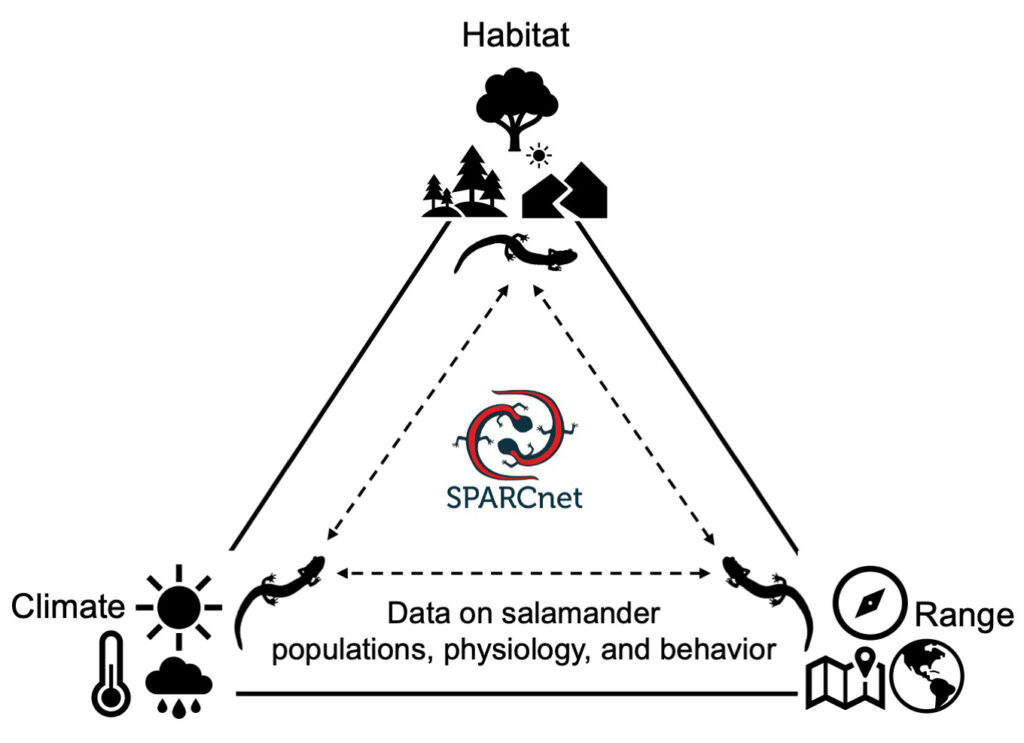
Core Project Research Questions:
- Population Ecology: How do salamander population structure and dynamics differ across different climatic conditions within the species’ range?
- Physiological Ecology: What is the relationship between environmental conditions and the growth and condition of individual salamanders?
- Behavioral Ecology: How do climatic conditions affect behavior of surface activity by salamanders and do these relationships vary among locations?
Tailored Project Themes & Example Research Questions:
- Behavior, e.g., how does salamander foraging behavior and surface activity vary with changes in climatic variables?
- Physiology, Morphology, and Genetics, e.g., does salamander physiology vary with environmental correlates among populations?
- Habitat, e.g., how do abiotic components, like temperature, moisture, or pH, of study plots correlate with local salamander densities?
- Prediction and Modeling, e.g., how are future climates predicted to affect future distributions of salamanders?
- Human Dimensions, e.g., how can we support effective science communication and engagement of SPARCnet research with land managers?
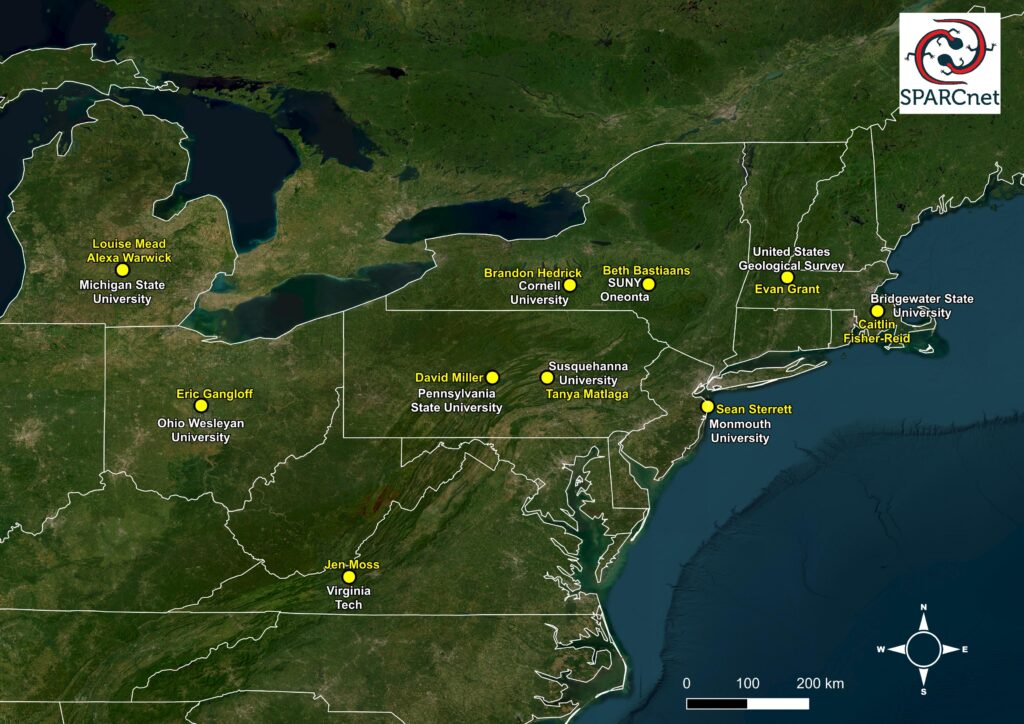
SPARCnet RaMP Mentors for the 2024-2025 Cohort
Click on mentor names to access their professional websites and learn more about their research.

Elizabeth (Beth) Bastiaans, Ph.D.
SUNY Oneonta
Oneonta, New York
The Bastiaans lab at SUNY Oneonta primarily focuses on behavioral ecology, especially questions relevant to conservation. We have six SPARCnet plots and a highly abundant population of red-backed salamanders, many of which are marked. Past projects in our lab have used the SPARCnet infrastructure and have also involved capturing salamanders from the surrounding forest. Students have investigated what factors affect whether a salamander moves from one cover board to another, how salamanders acclimate over time to changing fall and spring temperatures, and how salamanders respond behaviorally and physiologically to tail autotomy. RaMP fellows in the lab would be welcome to design projects taking advantage of our ability to track individual salamanders over time and asking questions related to behavior, growth, physiology, or genetics. We anticipate mentee questions will be in line with the RaMP research theme: “investigate patterns in salamander response to variable environmental conditions, examine mechanisms and processes that underlie these patterns.”

M. Caitlin Fisher-Reid, Ph.D.
Bridgewater State University
Bridgewater, Massachusetts
The Fisher-Reid Lab at BSU uses genetic tools to explore salamander population ecology and evolution. Past projects in the lab have explored how differences in macroclimate, microclimate, and land use (e.g., habitat fragmentation) can affect population genetic diversity and gene flow between populations, and the implications of these effects on population resilience to climate change. RaMP Participants will design a project that uses common genetic tools to generate population genetic data and then explore genetic variation across SPARCnet sites. These genetic data can further be analyzed in the context of Core Project data on salamander survival and density and macroclimate data from GIS databases, to better understand the role of genetic variation in population dynamics.
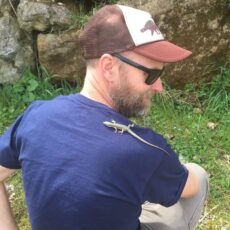
Eric Gangloff, Ph.D.
Ohio Wesleyan University
Delaware, Ohio
The Gangloff Lab of Amphibian and Reptile Ecophysiology (GLARE) utilizes a variety of field and lab approaches to quantify the capacity of these ectothermic vertebrates to respond to novel or changing environments, with special attention on thermal biology. Our salamander research at two SPARCnet sites, including one in partnership with the Peterman Lab at the Ohio State University, includes the use of infrared thermography to quantify both fine- and broad-scale patterns in thermal environments and how this affects salamander behavior. RaMP participants will have the opportunity to pursue a project related to characterizing variation inindividual temperature selection across both space and time in the context of changing environments. This work can include a combination of field observations, manipulation of natural environments, and laboratory-based measures toward the goal of linking individual behavior and physiology to population-level processes.

Brandon Hedrick, Ph.D.
Cornell University
Ithaca, New York
The Hedrick Lab works to explore evolutionary ecology and how different species have been capable of colonizing novel niches through a variety of field-based and computer-based techniques. RAMP participants will have the opportunity to participate in data collection for an ongoing red-back salamander project looking at how elevational changes in microclimate in the Ithaca area impacts space-use and demography. Participants will also be able to contribute to different projects in the lab examining how either intra- or interspecific morphological or physiological differences in plethodontid salamanders may allow them to live differently in different environments. Specifically, in conjunction with the Farallo lab at the University of Scranton, participants can examine changes in metabolic rates, using a stop-flow respirometry system, across seasons at different elevations in red-back salamanders. Students can also choose to work on a morphologically-oriented project, either examining morphological changes in New York red-back salamanders through time or looking at morphological variability across the red-back salamander range.
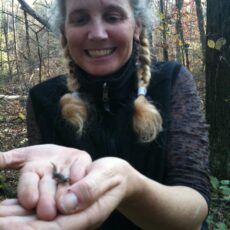
Louise Mead, Ph.D.
Michigan State University
East Lansing, Michigan
The current research interests of students in my lab stem from my role as coordinator and primary instructor for the Department of Integrative Biology's 355L Ecology Lab. Undergraduates participate in SPARCnet as part of the lab and a few continue to undertake research on the system either as an independent study or other means of funding. In general my students are involved in projects focused on testing ecological and evolutionary hypotheses related to the mechanisms that impact population dynamics and variation among population and species. Current research projects at Michigan State University include participation in the Salamander Population Adaptation Research Collaboration network (SPARCnet), an investigation of the possible role bacteria have in intraspecific communication in red-back salamanders, and testing various marking methods. Another individual is using trail cameras placed throughout one of the wildlife research areas to investigate a question related to deer movement but SPARCnet RaMP students would have access to both the data from the trail cameras as well as the opportunity to use trail cameras to examine other questions. We have educational and research plots set up on campus and the ability to create specific experimental set-ups in a forest on campus.
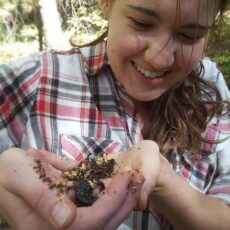
Jeanette (Jen) Moss, Ph.D.
Virginia Tech
Blacksburg, Virginia
The Moss Lab at Virginia Tech combines natural population monitoring with rigorous field and laboratory experiments to explore the intersections between climate change, behavioral ecology, and reproduction in red-backed salamanders. This lab is a brand new lab (starting in 2024) with opportunities to explore various aspects of sex-specific thermal biology as they relate to mating strategies. Potential projects will examine effects of warming during the extended courtship season (October-March) on male/female activity time, energy allocation, and social behavior. Experimental insights will be complemented with analysis of long-term datasets to investigate how short-term thermal responses at the individual level carry over to influence long-term patterns of social organization across geographic and temporal clines in temperature. Located in the heart of the southern Appalachians and a short drive from Mountain Lake Biological Station, participants in this lab will have a large hand in starting up new long-term monitoring plots and developing in-house databases.
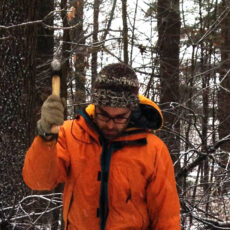
Evan H. Campbell Grant, Ph.D.
United States Geological Survey
UMass Amherst
Turners Falls, Massachusetts
The Northeast Amphibian Research and Montioring Initiative (NEARMI) research program at the U.S.G.S. Conte Anadromous Fish Research Laboratory uses field data and quantitative models to understand population dynamics and support Federal and State partners (e.g., U.S. Fish and Wildlife Service, National Park Service) in their conservation decision-making. NEARMI offers two SPARCnet RaMP opportunities: (1) RaMP participants will design and carry out an experiment to understand the how resource acquisition varies among microhabitats with varying complexity and environmental conditions. The experiment will replicate microhabitats and environments where arthropod disease vectors are present in large abundances, and will result in a better understanding of the role red-backed salamanders may play in control of disease vectors. (2) RaMP participants will investigate the potential to combine datasets from Core Project capture-mark-recapture sites with less intensive, but more spatially extensive, count data.
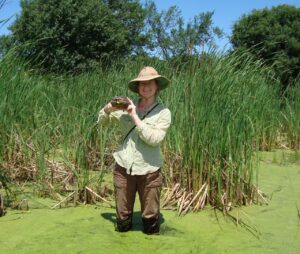
Tanya J.H. Matlaga, Ph.D.
Susquehanna University
Selinsgrove, Pennsylvania
The Matlaga Lab at SU examines fundamental and applied ecological questions with amphibian species using a variety of tools. Primarily we focus on the role of biological variation in mediating response to anthropogenic changes such as habitat modification and climate warming, both across species (i.e., life-history strategies) as well as within species (i.e., trait plasticity). RaMP mentees will develop a project to examine how behavior and physiology interact to influence salamander demography on local and regional scales. We will address questions using observational and experimental data from live salamanders and models in the field and lab. We will also examine these questions with demographic data collected from local SPARCnet plots and collaborate with others across the network. Our work will contribute to a better understanding of how behavior and physiological traits mediate demographic responses to changing abiotic conditions.
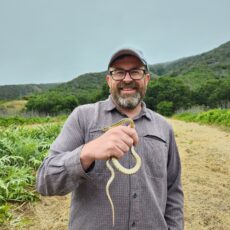
David A.W. Miller, Ph.D.
Pennsylvania State University
State College, Pennsylvania
The Applied Population Ecology Lab at Penn State University seeks to understand how climate and land-use change affect wildlife populations and communities. The mentee will join an active and dynamic lab that includes undergraduate students, graduate research assistants, post-docs, and field and lab technicians working to address real-world conservation needs. Our research focuses on innovative field and statistical approaches to quantify how wildlife populations respond to stressors. The mentee will have the opportunity to work on one of two potential research areas. The first topic would focus on understanding the behavioral responses of local salamanders to environmental variation. Using data collected at field sites to understand when animals are active on the soil surface and how that varies across environmental gradients. The second potential topic would focus on quantifying current historic distributions of red-backed salamanders across their range using a combination of historic and contemporary citizen science data to estimate how distributions have shifted across time and the current status of the species across its range.

Sean Sterrett, Ph.D.
Monmouth University
West Long Branch, New Jersey
The Sterrett Wildlife Ecology Lab at Monmouth University works on basic and applied research that contributes to improved decision making for wildlife populations. There are a number of challenges for understanding the movement ecology of particularly small organisms, such as plethodontid salamanders, despite this information being critical for understanding how this group, and others like it, may adapt to climate change. More recently, several studies have demonstrated that PIT tag telemetry is a viable option for studying the movement of Plethodon salamanders with methods comparable to traditional approaches such as radiotelemetry. RaMP participants will design a set of studies for understanding the surface and/or vertical movements of red-backed salamander with the opportunity to compare these results to modeled space use estimates that are inherent in the spatial capture recapture framework of SPARCnet.
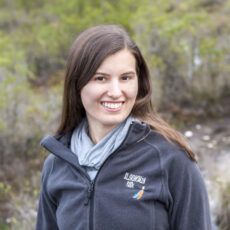
Alexa Warwick, Ph.D.
Michigan State University
East Lansing, Michigan
The Warwick lab addresses ecological, social science, and education/outreach research questions. Past projects investigated: the frequency and type of avian predation of salamanders; how human activities impact the spread of amphibian disease through the pet trade; abundance and diversity of reptile and amphibian communities in a degraded and soon to be restored wetland; how participation in a course-based research experience with SPARCnet impacts students’ science identity; and a review of published scientific literature to identify gaps in our understanding of the human dimensions of reptiles and amphibians. RaMP participants will have access to 6+ years of spatial mark-recapture data of red-backed salamanders from our six research plots on the Rose Lake State Wildlife Area near campus. Two additional salamander plots are monitored at the adjacent MSU Corey Marsh Ecological Research Center. Tailored projects could investigate among-population differences in habitat to better explain differences in local salamander densities. These results could in turn provide guidance to land managers as a broader impact. Participants could also investigate the human dimensions of salamander conservation, either expanding on disease in the pet trade efforts, or addressing how humans value the role of salamanders in ecosystems and how SPARCnet can better support engagement with land managers. Dr. Warwick works jointly with MSU Extension and Michigan Department of Natural Resources to develop engagement programs for stakeholder audiences and the general public, which can provide additional professional development and networking opportunities for RaMP participants.
SPARCnet RaMP Co-Mentors for the 2024-2025 Cohort
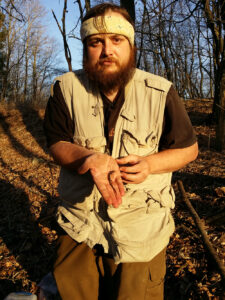
Co-Mentor Vincent (Vinny) Farallo, Ph.D.
University of Scranton
Scranton, Pennsylvania
Working with Brandon Hedrick
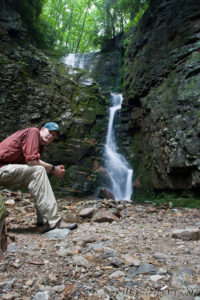
Co-Mentor William (Bill) Peterman, Ph.D.
The Ohio State University
Columbus, Ohio
Working with Eric Gangloff
SPARCnet RaMP Coordinators
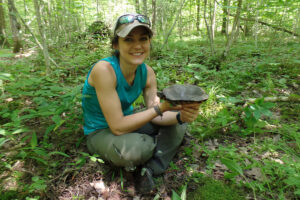
SPARCnet RaMP Research Coordinator
Carli Dinsmore, M.S.
Pennsylvania State University
State College, Pennsylvania
 SPARCnet RaMP Program Coordinator
SPARCnet RaMP Program Coordinator
Bethany Ozolins, M.S.
Bridgewater State University
Bridgewater, Massachusetts
